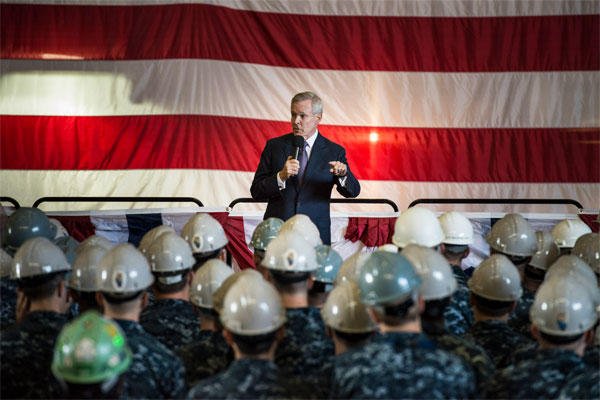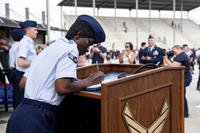Navy Secretary Ray Mabus outlined Wednesday a wide ranging list of personnel initiatives the service plans to execute to include changes to the Navy's promotion system, more paid maternity leave and a Career Intermission Program in hopes of attracting and keeping sailors in the service.
Mabus details in a speech at the U.S. Naval Academy to a broad range of initiatives and changes for officers and enlisted personnel designed to attract, promote and retain sailors at a time when Navy officials fear an improving economy could sink military recruitment and retention.
While many of the initiatives pertain to both male and female members of the Navy, a handful of the emphasized proposals, such as extending maternity leave and childcare hours, were aimed at appealing to women and families in the Navy.
For instance, female sailors will receive twice as much paid maternity leave under a proposal to extend the time period from six to 12 weeks. The Navy Secretary also proposed providing extra hours of child care support, and eliminating sex-specific uniforms.
"To make sure you have the time to spend with your newborn, we are proposing legislation that will double paid maternity leave from 6 to 12 weeks starting next year," Mabus said in his remarks, adding that the service needs to recruit more women.
Mabus also said he wanted to expand the number of combat roles women could fulfill in the Navy.
"I'm personally committed to opening all operational billets to women," he added. "In all cases, I personally believe we ought to have one standard for both sexes, a standard that matches the demands of the job, and if you pass, you pass."
The Navy Secretary said Wednesday the service is considering moving toward a common male-female uniform, he said.
Related Video
"In the Navy and in the Marine Corps, we are trending towards uniforms that don't divide us as male or female, but rather unite us as sailors or Marines. We've conducted a thorough review and both services have already initiated the transition," he said.
To support families, Mabus said the service would expand Child Care Development Center services by two hours on both ends of the period now served – 6 a.m. to 6 p.m. The Navy Secretary acknowledged that the high op-tempo at sea for sailors could take a toll on family life and emphasized that strengthening support to families was important to the Navy.
"That should mean that sailors don't have to worry about child care centers not opening early enough or closing too early. For dual-military couples, who doubly commit to service, we are updating our co-location policy, focusing on much improved opportunity for career progression, joint-service colocation, and active/reserve integration," he said.
Keeping Sailors in the Service
As the economy continues to improve, the Navy is likely to face more challenges when it comes to keeping its most talented sailors. As a result, Mabus announced a series of changes to the current promotion system such as ensuring that advancement opportunities are more merit based and less bureaucratic.
"We will begin adjusting Navy enlisted advancements this year by replacing the Command Advancement Program with a Meritorious Advancement Program, or MAP, that allows commanding officers to petition for more of these advancements, or to surrender unused ones," he said. "In October, we will expand the number of available MAP advancements to 5-percent of the force and extend them to shore-based commands."
This initiative followed round criticisms of the Navy's officer promotion system that excluded a disproportionate number of Naval aviators from advancement. The Navy had already begun exploring adjustments to the process in reaction to these concerns.
In addition, a number of the initiatives were aimed at expanding career path opportunities, timelines and options for members of the Navy – something the service has been emphasizing in recent months.
The idea is to allow for flexibility and partial alterations of a typical or standard career path in the Navy to allow sailors to spend time away from the service in the private sector for periods of time or stagger their sea and shore duty to allow time for personal pursuits such as starting a family.
Along these lines, Mabus said the Navy will expand fully-funded, in-residence, graduate programs at civilian universities by 30 billets.
"So if you learn your trade and you excel, we will send you to our nation's top institutions," he said.
Career Intermission Program
Mabus also announced a massive increase in what the Navy calls its Career Intermission Program, or CIP, an effort which allows members of the Navy to spend time away from the service, and then return, without damaging long-term advancement.
"I've submitted a legislative proposal to increase CIP billets from 40 to 400, and we are submitting follow-on proposals that allow participants to consider a menu of compensation, health-care, and timing options tailored to their needs," he explained.
The CIP program allows Navy members to spend time in academia or the private sector as part of their overall career path in the service.
Along similar lines, Mabus announced that the Navy will partner with Fortune 500 CEOs to create what's called the "Secretary of the Navy Industry Tour." This program will allow commanders to send their officers to work at U.S. companies for a period of time before returning to the Navy.
Body Composition Standards
The Navy is also changing the way it measures body fat as part of its physical fitness assessment standards, Mabus explained.
"We will completely revamp the Physical Fitness Assessment. Our pass/fail system that only, and often inaccurately, assesses one aspect of overall fitness will end. We will instead focus on evaluating health, not shape," he said.
As part of the prior system, sailors have been required to meet certain weight requirements for specific heights. All sailors need to pass a semi-annual physical fitness assessment. Some of the physical readiness tests for sailors include curl-ups, push-ups and a 1.5-mile run.
The Navy has been working on creating new Body Composition Assessment standards for months now – part of a broader recognition that the antiquated current system needed to be updated. Physical standards for BCA are being revisited because they are decades old and the demographics of the force have substantially changed in recent decades, senior Navy leaders said.
Mabus also said the Navy would be sure to open a 24-hour gym on every Navy base worldwide.
-- Kris Osborn can be reached at kris.osborn@military.com



























